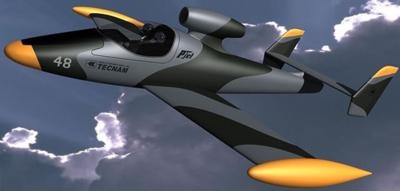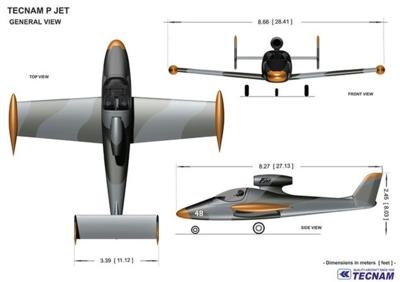Thu, May 14, 2015
Would Be A Two-Place, Single Engine Jet Airplane Targeted To The Military
Tecnam is actively evaluating the potential of developing and producing a two-place, single turbofan engine powered aircraft, according to the company.

Tecnam said on its website that "innovative developments are driven by customer demand," and "extensive interest has been shown for the introduction of a two seat (side by side), turbofan engine powered aircraft, to be used by military Flight Training Organizations, but also to offer a significantly faster and more efficient aircraft for both the private and business aviation sectors."
The ‘P JET’ will undoubtedly be a game-changer not only in the world of General Aviation but also as a first level entry military training jet powered aircraft. Tecnam’s initial research suggests that manufacturing this visionary aircraft is both technically and economically achievable. The remarkable progress in the development and reliability of thermic and mechanical efficiency now available in high bypass, two-spool turbofan engines, along with major advances in materials ensures that production of the ‘P JET’ is a feasible proposition.

The anticipated ‘P JET’ aircraft configuration would see the engine ‘podded’ thus ensuring the maximum efficiency to achieve the full ram-air intake effect, as this would not interfere with the primary aircraft structure and would also enable easier access for maintenance inspections, complete engine disassembling and other servicing requirements as well as enhanced safety protection such as fire.
Other key design features will include a twin-tail vertical stabilizer: its shielding effect to the horizontal surface will increase (being equal the exposed surface) the control power and stability.
Tecnam anticipates that the ‘P JET’ cabin will be available both pressurized and non-pressurized, for use with an airframe integrated oxygen system.
Development will be based on achieving CS-23 and FAR 23 certification.
(Images provided by Tecnam)
More News
Takeoff Roll The process whereby an aircraft is aligned with the runway centerline and the aircraft is moving with the intent to take off. For helicopters, this pertains to the act>[...]
“We’re proud of the hard work that went into receiving this validation, and it will be a welcome relief to our customers in the European Union. We couldn’t be mor>[...]
"Aircraft Spruce is pleased to announce the acquisition of the parts distribution operations of Wag-Aero. Wag-Aero was founded in the 1960’s by Dick and Bobbie Wagner in the >[...]
IDENT Feature The special feature in the Air Traffic Control Radar Beacon System (ATCRBS) equipment. It is used to immediately distinguish one displayed beacon target from other be>[...]
Aero Linx: Pararescue Air Force Pararescuemen, also known as PJs, are the only DoD elite combat forces specifically organized, trained, equipped, and postured to conduct full spect>[...]
 ANN's Daily Aero-Term (05.10.24): Takeoff Roll
ANN's Daily Aero-Term (05.10.24): Takeoff Roll Aero-News: Quote of the Day (05.10.24)
Aero-News: Quote of the Day (05.10.24) Aero-News: Quote of the Day (05.11.24)
Aero-News: Quote of the Day (05.11.24) ANN's Daily Aero-Term (05.11.24): IDENT Feature
ANN's Daily Aero-Term (05.11.24): IDENT Feature ANN's Daily Aero-Linx (05.11.24)
ANN's Daily Aero-Linx (05.11.24)




